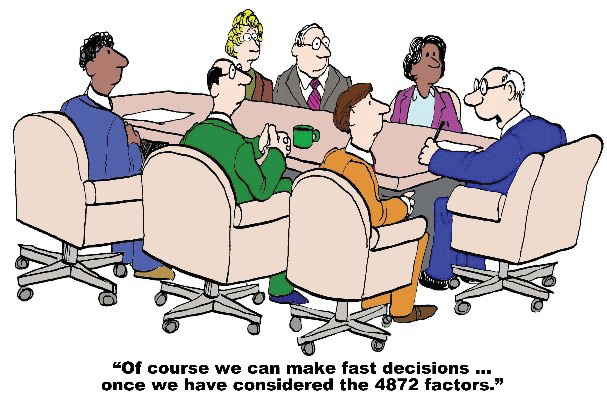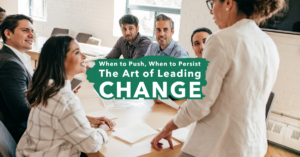I’ve been the victim of disastrous decisions made from “on high” – well-meaning corporate types who had no idea how their dictates impacted operations at the local level. And not all were disastrous, but many were ill-conceived, not very practical, or at times, bewildering and laughable.
I’ve also been the corporate type – struggling to make one decision that served many, being blind to the specific nuances, and awed by the complexity of implanting something across large global organizations.
And too, I’ve suffered through my fair share of mind-numbing meetings attempting to get to consensus. And been a part of way too many projects that were stalled as key decisions were held hostage to the notion that a consensus must be reached.
I’ve also led my fair share of meetings trying to get to consensus. Often successful if the issue was minor or the culture was compliant. Often frustrated if the issue was major or the culture was one that pushed back.
And no matter whether leading a decision or participating in consensus decision making, often experienced decisions that were watered down, or awkwardly cobbled together, or crafted to the least common denominator.

And so I cheered as I read Fredric Laloux’s new book, Reinventing Organizations, where he described a third way of organizational decision making – the advice process.
First some background: Laloux’s book describes an emerging model for organizations that are more agile, more adaptive, more holistic, and are described by him as “the next stage of organizations which involves taming our ego and searching for more authentic, more wholesome ways of being.” His conclusions are drawn after the study of twelve organizations across industries and across the globe who are successful and operating with fresh ways in the areas of self-management, encouraging people to show up as their “whole” self and have an overarching purpose, well beyond predicting and controlling. (Note to reader: This book speaks to me, so you’ll most likely hear more about the ideas in future blog postings.)
So back to this third way of making decisions, one that is not top down / hierarchical and is not consensus driven. LaLoux describes this as the “advice process” and each of the twelve organizations he studied used this decision making process in some way (even though these organizations were not aware of each other). In its simplest form, it allows anyone in the organization to make a decision with one overarching criteria: they must seek advice from anyone impacted by the decision AND anyone with expertise in the matter. That advice must be considered, but is not mandated to be incorporated in the final approach. In other words, all stakeholders in the decision and those with wisdom to share have a voice but not a vote in the decision. By design, the bigger the decision, the more people are impacted and the more conversations and advice is sought.
Dennis Bakke, founder and CEO of AES, a global electrical production and distribution company with 40,000 employees, uses the advice process and cites these outcomes in a quote from the book:
First, it draws people whose advice is sought into the question at hand. They learn about the issues and become knowledgeable critics or cheerleaders. The sharing of information reinforces the feeling of community. Each person whose advice is sought feels honored and needed.
Second, asking for advice is an act of humility, which is one of the most important characteristics of a fun workplace. The act alone says, “I need you.” The decision maker and the advisor are pushed into a closer relationship. In my experience, this makes it nearly impossible for the decision maker to simply ignore the advice.
Third, making decisions is on-the-job education. Advice comes from people who have an understanding of the situation and care about the outcome. No other form of education or training can match this real-time experience.
Fourth, chances of reaching the best decision are greater than under conventional top-down approaches. The decision maker has the advantage of being closer to the issue and ….usually has to live with the consequences of the decision.
Fifth, the process is just plain fun for the decision maker because it mirrors the joy found in playing on sports teams…..the advice process stimulates initiative and creativity, which are enhanced by wisdom from knowledgeable people elsewhere in the organization.
The process is bottom-up, but it is not loosey-goosey, anything-goes affair. It involves creativity, careful analysis, meticulous planning, and disciplined execution.
How advice is sought varies, from individual conversations to meetings. For decisions that impact many, the company intranet might be utilized to gather counsel from many.
So I’m intrigued. At its core, the advice process sees people as creative, trustworthy and capable. It cultivates shared learning. It is a highly accountable process, for if you see something that can be done better – you are able to do something about it. It builds community and eliminates the “shock and awe” that occurs when big decisions are made on high land. It puts decision making close to the core – where there is deeper wisdom and greater urgency. Depending on the size of the decision and the number needing to be consulted, it is not necessarily fast, but neither is it likely to be stalled nor knee-jerk.
I do feel the need to add a disclaimer: Please note that the advice process for making decisions is done in organizations that have a very different structure than a traditional organization. They look and feel and operate differently. Which is to say that the advice process may need to be adapted somewhat to work in your organization. None the less, I’d encourage you to give it some thought and perhaps a bit of experimentation.
I’m curious to see if any of the organizations you work with and in are doing something similar. If so, I’d love to hear about your experience. Please share!




